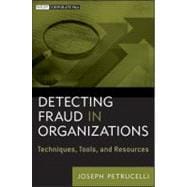
Note: Supplemental materials are not guaranteed with Rental or Used book purchases.
Purchase Benefits
What is included with this book?
JOSEPH R. PETRUCELLI, CPA/CFF, FCPA, CVA, CFFA, PSA, CFE, is a founding partner of PP&D Accounting Services, Inc., and Fraud Forces, Inc., where he provides forensic accounting, tax, and consulting services, including testifying and preparing for trial as a qualified expert. He is also an adjunct professor teaching accounting and taxation-related courses, including advanced forensic accounting. He was part of the development team on the fraud risk management and detection certification curriculum of Consultants' Training Institute (CTI), a division of the National Association of Certified Valuators and Analysts (NACVA).
Preface
Acknowledgments
Introduction
The 800-Pound Friendly Gorilla
Numbers Don’t Lie, People Do
An Overview of Fraud
This Book’s One Minute Fraud Mysteries
A Few Tips for Detecting Fraud as You Begin
This Book’s Setup
Chapter 1 Understanding Fraud
What Is Fraud and Why Does It Continue to Happen?
People Are Greedy - How Greedy Are You?
One Minute Fraud Mystery: Trust Us, Inc.
Distinguishing between Deterrence, Prevention, and Detection
Increased Risk of Fraud Loss
Divergent and Convergent Thinking
Critical Thinking Requires Critical Questions
Personality Traits of the Fraudster
The Moral Compass
MIRD (Misrepresentations, Intent, Reliance, Damages)
Confusion about Responsibility
Complexity
Summary
One Minute Fraud Mystery Analysis
Chapter 2 Fraud Detection Approaches
Why Doesn’t Enhanced Legislative, Regulatory, and Professional Oversight Help to Prevent Fraud?
One Minute Fraud Mystery: Big Fish Investment, Inc.
Principles and Rules Alone Cannot Exterminate All Fraud
Getting a Handle on Transactions
The 10 Forensically Accepted Generally Accepted Accounting Principle Assumptions (FAGAAPAs) No No’s
Summary
One Minute Fraud Mystery Analysis
Chapter 3 Deciding to Commit Fraud
What Is the “Something” that Coerces Folks to Cross the Line?
One Minute Fraud Mystery: The House of Worship
Do You Really Know What the People in Your Organization Are Thinking?
The Four Generations and Motivation
Pinpointing the Fraudster
The Three Most Prevalent Types of Fraud
An Accounting Creed
Consequences of Fraud
Summary
One Minute Fraud Mystery Analysis
Chapter 4 How to Act Like a Fraudster
To Catch a Fraudster, You Need to Think Like One
One Minute Fraud Mystery: Catch Me If You Can Inc.
The Six Ps of Successful Fraudsters
The Characteristics of a Fraudster
Fraudsters & Their Organizations
Summary
One Minute Fraud Mystery Analysis
Chapter 5 The Dynamics of Business
Everything Is Related -- From People to Processes to Outside Influences
One Minute Fraud Mystery: Accrual, Inc.
Control Point Links and Accountability
The Layers of Trust
Responsibility Chains
A Failure in Management
More than the Bottom Line
Outside Influences
Organizational Failures
Understanding Cash Flows
Summary
One Minute Fraud Mystery Analysis
Chapter 6 Understanding the Accounting Process
One Minute Fraud Mystery: Sneakers Are Us, Inc.
Understanding the Sale of Goods
Deceptive Data
Operating Expenses
Balanced Principles
Balance Sheet Components
Ratio Analysis
Building a Case: Document Organization, Data Analysis, and Lifestyle Analysis
Summary
One Minute Fraud Mystery Analysis
Chapter 7 It All Comes Down to Cash
One Minute Fraud Mystery: Yankee
Handling Cash
Cash Disbursements Controls
Cash and Fraud
Classifications of Cash and Cash Equivalent Fraud Schemes and Scenarios
Fraud Control Points in the Organizational Process
Summary
One Minute Fraud Mystery Analysis
Chapter 8 Final Thoughts
Handy Tips and Quick Checklists for Reference
Finding the Next Potential Fraud Kernel in Your Organization Before it POPs (Perspective + Occupation + Position)
Quick References Regarding the Fundamentals of Fraud
Generally Accepted Accounting Principles (GAAPs) versus Forensically Accepted Generally Accepted Accounting Principle Assumptions (FAGAAPAs): A Summary
Why Auditors/Accountants Fail to Detect Fraud
Red Flags Indicating Potential Fraudsters
Using Ratios
A Simple Fraud Risk Plan
Conclusion
Bibliography
About the Author
Index
The New copy of this book will include any supplemental materials advertised. Please check the title of the book to determine if it should include any access cards, study guides, lab manuals, CDs, etc.
The Used, Rental and eBook copies of this book are not guaranteed to include any supplemental materials. Typically, only the book itself is included. This is true even if the title states it includes any access cards, study guides, lab manuals, CDs, etc.